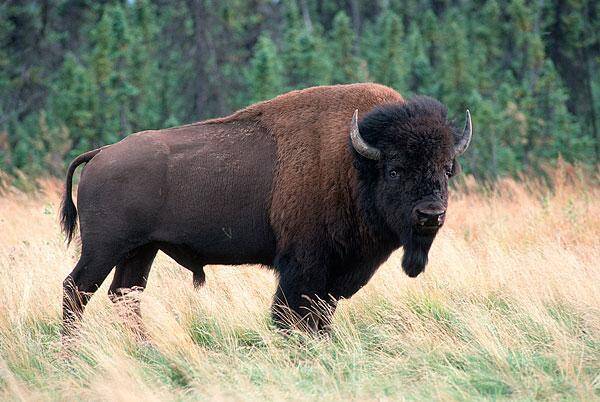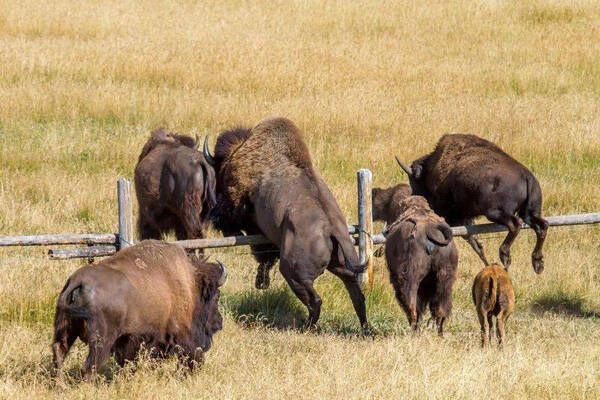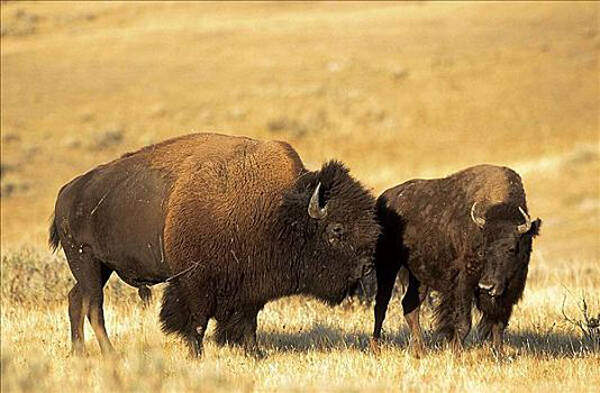Bison bison
IUCN
LCBasic Information
Scientific classification
- name:Bison bison
- Scientific Name:Bison bison,bison, American buffalo, bison
- Outline:Ungulata
- Family:Artiodactyla Bovidae Bison
Vital signs
- length:2.1-3.5m
- Weight:350-1000kg
- lifetime:18-40years
Feature
It is the national animal of the United States
Distribution and Habitat
Resides in: Canada (Alberta, Ontario, Manitoba, British Columbia, Saskatchewan, Northwest Territories and Yukon Territories), United States (Utah, Arizona, Montana, Idaho, Wyoming, South Dakota and California).
Suspected extinct: United States (Texas).
Extinct: United States (Maryland, Colorado, Wisconsin, West Virginia, Kansas, Missouri, Iowa, Nevada, Kentucky, Oklahoma, Virginia, North Carolina, Florida, New York, North Dakota, Georgia, Mississippi, District of Columbia, Delaware, Arkansas, Ohio =American bison (Bison) is found in northern Mexico to Alaska. The prairie bison (B. b. bison) is found from northern Mexico to central Alberta, Canada. The wood bison (B. b. athabascae) is found from central Alberta, Canada to Alaska, USA. The prairie bison (B. b. bison) is found from northern Mexico to central Alberta, Canada to Alaska, USA. The prairie bison (B. b. bison) is found from central Alberta, Canada to central Alaska, USA. The prairie bison (B. b. bison) lives in grasslands
Appearance
The American bison is 2.1-3.5 meters long, 1.5-2.0 meters high at the shoulder, and weighs 350-1000 kilograms when grown. The head and front part are huge, the shoulders are like towering camel humps, the neck is short and strong, the head is large and has a broad forehead, and both male and female bison have short and curved horns, which can be used for fighting and defense. The American bison looks a bit like a domestic dairy cow, with long and fluffy coarse hair on the shoulders, covering the head, neck, shoulders and forelimbs. The hair is dark brown in winter and thinner and lighter in summer. In spring, the soft hair on the back and lower part of the body will fall off.
The hair on the head, neck and front of the American bison is longer and denser than that of the European bison, the body is shorter, the pelvis is smaller, and its hindquarters is not as developed as that of the European bison. In general, the body of the American bison is thicker than that of the European bis
Details
American bison (scientific name: Bison bison) is called American Bison in English and Amerikanischer Bison in German. It has two subspecies.

American bison live in large numbers on the Great Plains of the United States and Canada, from the Great Slave Lake in the far north of Canada to Mexico in the south, and from eastern Oregon to the Atlantic Ocean. Large herds of American bison roam back and forth on the Great Plains. They migrate south in the winter and return north in the summer. They travel along traditional routes known as "bison trails."
The American bison is very similar to the European bison in appearance, but there are some changes in their habits. The European bison lives in the forest and feeds on tender leaves and small shrubs, while the grassland subspecies of the American bison is a herbivore that lives on the grassland.
The American bison lives in herds. They often trudge in the mud and like to take mud baths. They rub their bodies against large rocks and tree trunks to remove external parasites. They feed mostly in the morning and evening, and rest the rest of the time. If attacked by wolves, they can run at speeds of up to 60 kilometers per hour. They are herbivorous. Grasses and sedges are the main food of this species, and other foods include leaves of flowering plants, woody plants, and even lichens. In winter, bison dig through the thick snow to find plants buried underneath.

American bison are one of the most dangerous animals in the US National Parks, especially Yellowstone National Park. Although they are not carnivorous, they will attack humans when provoked. They usually move slowly, but when they run, they can easily surpass humans, running at a speed of up to 56 kilometers per hour. Between 1978 and 1992, more than five times as many people were killed or injured by bison in Yellowstone National Park than by bears (12 bears, 56 bison). Bison are also unpredictable, and their size and structure allow them to easily jump over a standard wire fence.
Bison form groups within their herds, with individual bulls defending the family group's females and driving off any other bulls that challenge them. The mating season runs from June to September, with peaks in July and August. The mating season is a spectacular fight between two adult males, who usually fight only during the breeding season for the right to mate with females, with loud roars, rolling in the dust, and then bobbing their heads to show off. At this time, usually one of the bison will give in. If not, the two will fight, head-to-head, causing a lot of hair to fly in the air, then they will circle each other, and then suddenly turn and rush forward, trying to stab their opponents with their horns. The gestation period of females is about 9 months (270-285 days), and only one calf is born per litter. The calf will be born in the spring of the second year. The body color of the newborn calf is light brown or reddish brown. Within three hours, the newborn calf can walk. The calf will be cared for by its mother for about a year. Generally, it is mature at the age of 3. The life span of wild bison is 18-22 years, and that of captive bison is 35-40 years.
After the European bison migrated to North America, they reproduced rapidly and grew very fast. The climate and environment in North America are very suitable for the growth of bison. However, when Europeans immigrated to North America, American bison suffered an astonishing massacre. People shot and killed about tens of millions of bison. By 1903, there were only 21 wild bison left on the North American prairie. In 1905, then-US President Roosevelt issued a decree that for the first time placed bison and other rare animals under national protection. Huge herds of bison finally spread across the North American prairie again, and their traces can be seen in many national parks.

The wild predators of American bison are mainly gray wolves and poisonous rattlesnakes. Young bison, in particular, are subject to winter attacks by wolves, and rattlesnake bites on the ankles of cattle, an injury that is sometimes fatal to calves.
In the 19th century, market, subsistence, and recreational hunting nearly exterminated the American bison throughout its range. Conservation efforts have led to limited recovery in the wild and in captive conservation herds. Private commercial production of bison has led to significant population recovery, but there is no provision for the conservation of bison as a wild animal under Red List designation. Existing threats include: habitat loss; genetic manipulation of commercial bison for market traits; low population impacts in most conservation herds; few herds exposed to the full range of natural limiting factors (natural selection); cattle introgression; loss of genetic non-exchangeability through hybridization between bison subspecies; and population decline threats as a management response to infection of some wild populations with reportable cattle diseases. Canada, the United States, and Mexico list bison as both wild and domestic animals nationwide. Legal status varies across state and provincial jurisdictions. In Canada, four provinces and two territories classify bison as both wildlife and livestock. In the United States, bison are legally classified as livestock, with only 10 states classifying bison as wildlife in all or part of the state. Another threat to the species' population is culling to prevent the spread of bovine tuberculosis and brucellosis.

On May 9, 2016, the 44th President of the United States, Barack Obama, signed a bill that officially established the American bison as the national animal of the United States. After becoming the national animal, the status of the American bison has been comparable to that of the American national bird, the bald eagle. Congressman William Lacy Clay, one of the drafters of the bill, commented on the status of the American bison: "No other native species can tell the American story better than this noble animal."
Listed in the "Red List of Threatened Species of the World Conservation Union" (IUCN) 2016 ver 3.1-Near Threatened (NT).
Protect wildlife and eliminate game.
Maintaining ecological balance is everyone's responsibility!








